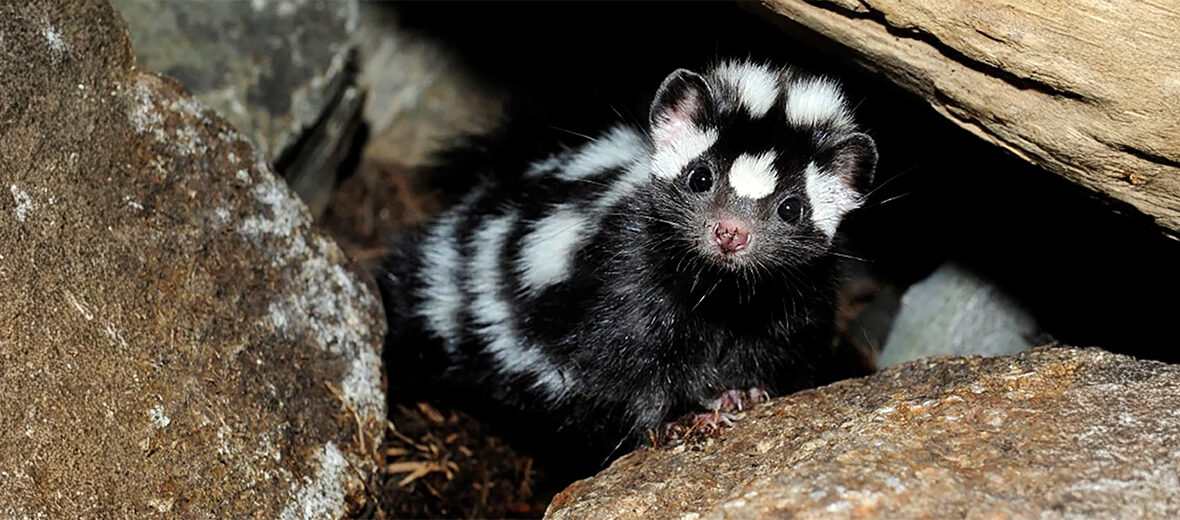
The western spotted skunk, like other skunks, has a pair of large musk glands that open just inside the anus, and which can spray their contents through a muscular contraction. These skunks face the threats of vehicle strike (being hit by vehicles); hunting, for their pelts; and trapping, as a pest species. However, they are abundant enough to be listed as Least Concern by the IUCN. Their population trend is listed as decreasing.
First the Stats…
Scientific name: Spilogale gracilis
Weight: Up to 4 lbs.
Length: Up to 18 inches, plus up to a 6.3 inch tail
Lifespan: Up to 10 years
Now on to the Facts!
1.) These skunks are trapped, shot, and poisoned during predator control runs.
2.) Pesticides also present a significant threat over portions of their range.
3.) They can be found in Canada, United States, Baja California, and Mexico.
4.) Their preferred habitats are mixed woodlands, open areas, and farmlands.
5.) Like other skunks, these critters are nocturnal (active at night).
But wait, there’s more on the western spotted skunk!
6.) Beetles, grasshoppers, scorpions, mice, moles, rats, voles, rabbit kits, small birds, small reptiles, amphibians, roots, grains, fruit, berries, eggs, and carrion (dead animals) are all on the menu.
7.) Golden eagles and great horned owls are their primary predators, sans humans.
Did you know…?
Their musk lacks some of the compounds produced by the other species of skunk. The differences are told to give the western spotted skunk’s musk a more pungent odor, but not spread as wide as that of striped skunks.
8.) While these critters don’t engage in true hibernation, they may sometimes sleep, on and off, for several weeks during the winter.
9.) During this quasi-hibernation females will often den together in surfeits (a group of skunks) as large as 20 individuals.
10.) When threatened, they will stamp their fore-feet before raising their hind end in the air to show their warning coloration. Even though they can spray by standing on their forelegs and raising their hindlegs and tail in the air, they most often do so with all 4 feet on the ground, bending their body around so that both their head and their tail face the attacker.
But wait, there’s still more on the western spotted skunk!
11.) Including a delayed implantation (where the female can hold onto male’s sperm for an extended period of time before officially becoming pregnant) the female undergoes up to a 250 day gestation (pregnancy) they yields up to 5 kits.
12.) Clinton Hart Merriam first described these skunks in 1890.
Did you know…?
Skunks are increasingly being kept as house pets and can be trained to use a litter box just like a domestic cat.
13.) There are 7 subspecies recognized: S. g. amphialus, S. g. latifrons, S. g. leucoparia, S. g. lucasana, S. g. martirensis, S. g. phenax, and of course S. g. gracilis.
14.) These critters can sometimes cause problems in rural areas, as they often make dens on private property and in the attics of homes, and have a tendency to steal eggs from farmers.
15.) They are just 1 of the many species of skunk that are opportunistic within the expansion of human civilization, and remain neither threatened nor endangered.
Now a Short Western Spotted Skunk Video!
This video talks about skunks in general.
Be sure to share & comment below! Also, check out the Critter Science YouTube channel. Videos added regularly!

Want to suggest a critter for me to write about? Let me know here.
Some source material acquired from: Wikipedia & IUCN
Photo credit: Fandom



